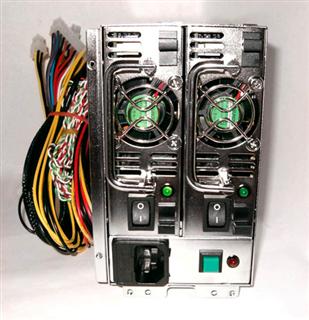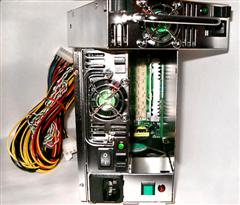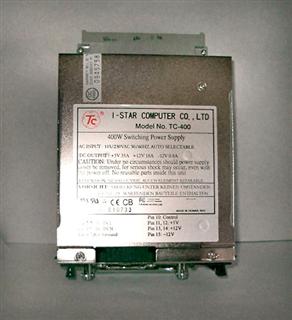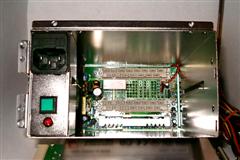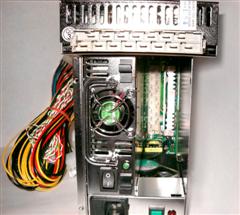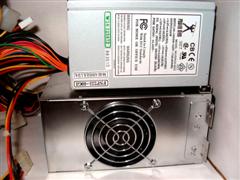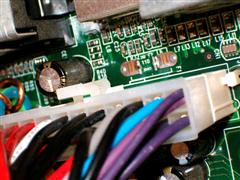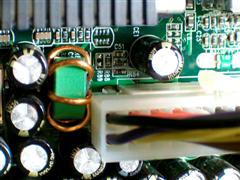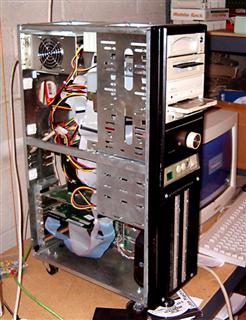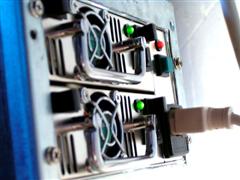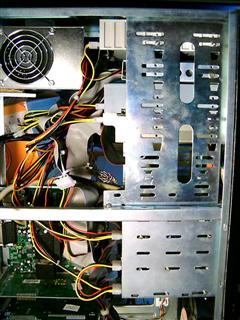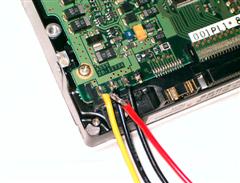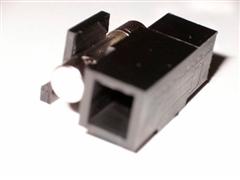Power supplies are an often overlooked yet extremely critical component of every PC. A solid and reliable PSU is an absolute must for a stable system. For a system that requires no down-time, then a redundant PSU is the answer. Check out this review of one of I-Star’s ‘mini redundant PSUs’ — they fit in regular ATX cases.
Introduction
Power supplies, like hard disks, are expected to work reliably: continually and consistently. A power supply unit is required to be as quiet as possible to enable a transparent user experience. Power supplies find themselves in a unique position: because of their inobstrusive (hopefully) nature, they tend to be one of the “forgotten” computer system components. All we hear today are the buzzwords “Megahertz”, “Gigahertz”, “Storage”, and “Graphics”, while the neglected power supply is left behind.
Interestingly, the scene changes dramatically once a computer goes into “the shop” for a repair. Here power supplies are among the first test victims, because even the slightest fluctuation or shortage of power can cause the strangest problems. Data loss, system crashes, and of course complete power failure can all result from a faulty power supply, so this lonely piece of equipment should never be left for last. In short, choosing an adequate power supply can make a real difference.
| Introducing I-Star’s TC-400R8 Mini Redundant Power Supply. |
I-Star has a solution for this serious issue. They have engineered a power supply of the standard-issue size and shape (PS/2) that allows advanced redundancy features. Effectively, this means “2 power supplies in one”, to allow for an exceptionally reliable source of energy. I have had the privilege of testing and using the TC-400R8, a high-end unit from I-Star’s repertoire of quality power supply products.
Package Contents / Quality
I-Star opted to include only the bare minimum: the power supply itself, a few screws and small mounting brackets, and a printout of the product specification PDF file. Unfortunately, an adapter for the device’s “server-style” ATX connector was not included. I decided that I would try to figure out an alternative to obtaining one; you can read about this during the “installation” section of this review.
| The individual power supply modules slide out simply, just by using the latches on the front. Each module is well-constructed and includes its own fan to maximize cooling capacity. |
Each component is very well constructed and feels solid and dense. The entire assembled power supply (with both power supply modules installed) is a heavy and impressive piece of equipment that managed to stun me with its “serious” appearance. The power supply includes a very generous 7 molex connectors and 1 floppy connector, which should be more than enough plugs in most circumstances. The ATX power cable itself is covered with what looks like a braided nylon material that bundles the power cable’s wires together neatly.
| Here you can see the empty shell unit. This thing is sturdy and well built. |
Features / Specifications
| I-Star TC-400R8 | |
| Features | Specifications |
| PS/2 Size Design | 90-132V/180-264V auto-select AC voltage |
| Hot-Swappable&Power Sharing Capability | +5V max 35A |
| Alarm Reset Button | +3.3V max 24A |
| Over-Voltage Protection | +12V max 18A |
| Short Circuit Protection | -5V max 0.5A |
| Over Power Protection | -12V max 0.8A |
| No-Load Protection | +5V S/B max 2.0A |
| UL/CE/TUV/CB/FCC Approvals | Reliability: 100,000hrs full load@25C Ambient Temp. |
Installation
This device can be conveniently installed in any standard case which supports PS/2-sized power supplies and supports a server-style backplane with a rectangular gap (3.375″ x 5.875″… Case builders such as Antec and others have cases like this, see the end of the review for some suggestions). Unfortunately no cases of this style were at hand for review but I had a perfect chassis to use for the required modifications.
| You can see that the TC-400R8 is over an inch longer than a regular ATX power supply. |
Installation is easy (provided your case supports the installation of a power supply with this style of backplane), although not as easy as with an ordinary unit. In my situation, because my case had to be modified in order to accomodate this power supply, it was a moderately challenging project. I was required to use the included angle brackets and mount them to appropriate locations on the power supply in order to fasten the unit to the case chassis (I used 8 of the included screws for this operation). This allows for a very secure and stable mounting to the case chassis.
Another difficulty encountered during installation was with the ATX power connector. The included connector that came with the power supply was designed for a server environment, and thus a server-class motherboard. As the test motherboard unfortunately did not have such accomodations (and there was no ATX adapter included), I examined the connector closely and compared it to the standard ATX connector from another power supply, resulting in the conclusion that the connectors are exactly the same except for 4 extra wires on one side. Simply shift the power supply connector over a bit during installation to obtain a standard ATX connection for your motherboard.
| Note the overhang on the left side of the ATX socket, this is where the extra pins lie. Also, note how the clip on the power supply cable falls directly to the left of the target clip on the motherboard’s ATX connector. This is how a server ATX connector should be installed on a standard ATX motherboard without an adapter. |
I must note the fan on the side of the power supply unit. It is important that you make sure your case can accomodate a fan on the side to allow enough airflow. The test case here was orginally a full tower AT chassis, but it was modified to accomodate ATX motherboards. This means that this chassis was narrower than comparable ATX cases, because the AT specification differs from that of the ATX specification. The air gap of slightly more than 1/2 inch is barely sufficient, but luckily there are spaces both above and below the unit that the fan can pull air from.
| Airflow is critical for a power supply to maintain a safe operating temperature. Here you can see that there would be barely enough airflow if the case was closed. |
Test System
I tested using the following system:
- Intel Pentium III 600 (100mhz FSB)
- Generic mobo ‘w i440BX chipset
- 128MB PC133 SDRAM
- Geforce2 MX 32MB
- Mandrake Linux 10
- Adaptec 2940UW SCSI Controller (Ultra-Wide)
Disk Subsystem (SCSI):
- (2) Seagate Hawk 2XL 5400RPM 2.1GB SCSI (ST32155W) Ultra-Wide, Half Height
- (1) Seagate Hawk 2 5400RPM 2.1GB SCSI (ST12400N) SCSI-2, Full Height
- (1) Seagate Hawk 2LP 5400RPM 1.06GB SCSI (ST31230N) SCSI-2, Half Height
- (1) Plextor 4x SCSI-2
- *(1) Quantum Viking II 4.5GB SCSI Ultra-Wide, Half Height
Disk Subsystem (IDE):
- (1) Western Digital 5400RPM 10GB
- (1) Plexxtor 12x10x32a CDRW
*Died in an unfortunate accident.
| The test chassis, a full-sized AT case. It has been modified with a fan control for a large AC fan on the bottom-front of the case, and a large air filter. |
Performance
Although it may seem hard to convey a power supply’s “performace”, there are many factors at play that simply cannot be overlooked. This is a redundant power supply, so it is important that we go over the various capabilities and reliability features that this unit offers. Another important attribute: noise level.
| The power supply has plenty of informative (and pretty) LEDs. The green ones indicate that each individual module is on, and the red one shows the status of the entire unit. Note the alarm reset button below the red LED. |
After installation of the TC-400R8, it can be hard not to notice the noise. This is not a whisper quiet power supply. Although definitely far from truly “loud”, this unit can be compared to a high-RPM fan running in your case. Don’t take this too harshly, though, because that is a small price to pay for your peace of mind.
If you can look beyond the noise, you will find all the pastures green and pristine: I have had NO problems with this power supply. There is simply no other way to state this. This device has proven reliable and has truly left me impressed and feeling confident that my system will continue running reliably and without interruption. Let’s examine the “redundant” features now.
Part of my testing methology involved a “long-term” test with each of the power supply’s individual slide-in power supply modules installed separately, running for a continual week (one drive in my array, the Seagate Hawk 2LP, was damaged after years of use in a server environment. However, the particular fault with this drive allowed for excellent load testing: the drive continually turned off, then revved back up to normal RPMs again…repeatedly). This allowed me to test more than the reliability of each module; this allowed me to try first-hand the hot-swapping capability offered by the TC-400R8. I bit my lip, closed my eyes, and yanked a module out of the power supply chassis to be greeted by an alarm. As the computer was still running prefectly, and with no noticable changes or crashes, I remembered the “alarm reset” button on the power supply unit, and hastily pressed the button to stop the alarm. The power supply had initialized the remaining module to 100% power flawlessly, without any noticeable interruptions. I took the removed unit and placed it on top of the computer case, and left the computer in this state for a week.
| You can see that every single connector is utilized in this picture. |
When I returned a week later, the computer was how I had left it. Everything was running fine. I decided that it would be good to test the removed module by itself as well, so I installed it into the empty slot above the remaining module without incident (no alarms sounded). I pulled out the other unit to the sound of the alarm I had heard a week before, hit the “alarm reset” button, and left the computer running for another week. Upon return, everything was still running fine so I replaced the unit and decided to continue with my testing.
At some point, I obtained a new motherboard, and decided that I would upgrade my test system. After installation, I reconnected the power supply, drive array (plus two more drives, a 4.5GB SCSI that a friend gave me and a 10GB IDE disk that I wanted to install in a removable tray), and installed the add-on cards. After playing around with the system, I apparently had bumped the 4.5GB SCSI drive and its “hack-job” power connector’s contacts touched the case chassis; upon power-up, there was a noise heard and smoke began billowing forth from the side of the case. I immediately pulled the power cable from the power supply and examined the damage.
| The Quantum Viking II accidently contacted metal. “Hack jobs” are obviously not recommended for hard disks, as this can be the result. |
The heat produced during the short was enough to melt a solder-point from the hard disk, and after disconnecting the drive, I couldn’t power-up the system again. Fearing a damaged motherboard and worrying even more that I had damaged the power-supply, I discovered (with a test motherboard) that the power supply indeed wasn’t working. This is when I dug into the provided user manual to see if there was anything that could be done. The fix was indeed simple. The power supply includes a small “fuse box” on the back, near the power connector. On removal of the fuse box, I found that the fuse had “blown.” Even more important, I found that I-Star had included a backup fuse within the “fuse box” for such an occasion. After swapping the burnt fuse for the good, the TC-400R8 worked flawlessly once again and my confidence was restored to even greater heights than before.
| The fuse box, which is located directly beneath the power cable socket on the power supply. This really can be a life saver! |
Conclusion
The performance I have experienced while using this device has been excellent, and (like I stated before) I find no real fault within this power supply. With so many people today purchasing hard disks to use in RAID configurations alongside high-power CPUs and video cards, a solid power supply is definetly within the best interest. In the TC-400R8 I-Star has created an exceptional piece of hardware that should be strongly considered by any serious PC enthusiast needing both a reliable and high-energy power source. The lure of a cheap, “garbage” power supply is strong only because of the price factor; however, consider the biggest asset that a truly reliable power supply offers: long-term operation with peace of mind. As a technician myself, I have seen more than half the hardware problems resolved with the replacement of a faulty or failed power supply. Even if one of the included modules manages to fail, I-Star offers replacement modules at a reasonable $85 apiece. This greatly helps protect your investment. I-Star’s TC-400R8 offers you an incredible value: problem-free operation for years to come.
The only real drawback to be found at this point is price. A product of this calibre does not come cheap. This is not an ordinary power supply. This power supply is designed for a serious user who requires the utmost in stability and power supply performance. The average home user likely would pass this by, but if you have critical data that you can’t afford to lose than I have to suggest that you consider this product.
Finally, I have to say that I-Star has left me feeling impressed and confident that this power supply will not let me down. This is a feeling that I have never before felt so strongly, and I will never go back. I give a rating of 9.5/10 and hereby award the I-Star TC-400R8 a Golden Bear Award, Bjorn3d’s highest award for exceptional quality and performance.
Power Supply Price: $288 at Newegg.com
Power Module Price: $85, purchased directly from I-Star
Warranty: 3 Years
Compatible case manufacturers: Antec,Silverstone, more…
Pros:
- Solid Construction
- Thoughtfully Designed
- Seamless Redundancy
- Hot-Swapping Modules
- “Install-and-forget” dependability
- Visually and physically impressive
Cons:
- Price
- Requires special backplane for mounting
- ATX adapter needed for non-server motherboards
Rating:
 Bjorn3D.com Bjorn3d.com – Satisfying Your Daily Tech Cravings Since 1996
Bjorn3D.com Bjorn3d.com – Satisfying Your Daily Tech Cravings Since 1996
